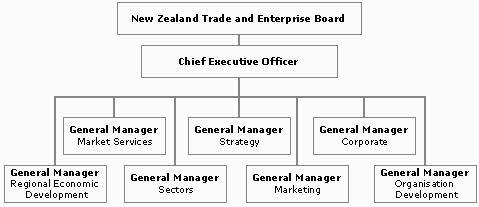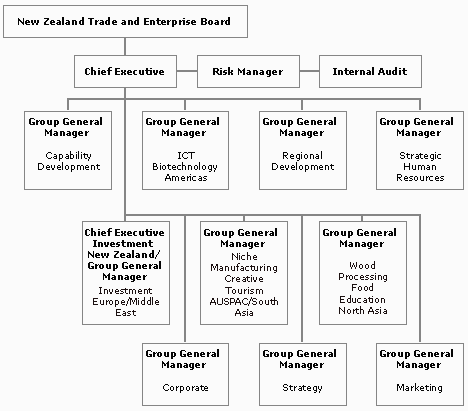Part 1: Introduction
- Why did we audit the administration of grant programmes?
- What is New Zealand Trade and Enterprise?
- How did we carry out our audit?
- Structure of our report
Why did we audit the administration of grant programmes?
1.1
It is important that agencies can assure Parliament that grants are given in accordance
with the Government’s intentions, and that grant recipients spend the money as
intended.
1.2
In 2003, we conducted 2 inquiries that revealed deficiencies in the administration of
grants. The Inquiry into Public Funding of Organisations Associated with Donna Awatere
Huata MP and Industry New Zealand – Business Growth Fund Grant to The Warehouse reports raised a range of issues around how well grant programmes are being
administered by government agencies.
1.3
We decided it would be timely to undertake a performance audit, under section 16(1)
of the Public Audit Act 2001, looking specifically at NZTE’s administration of grants.
What is New Zealand Trade and Enterprise?
1.4
New Zealand Trade and Enterprise (NZTE) was formed on 1 July 2003, following the
merger of Industry New Zealand and Trade New Zealand. Trade New Zealand was
the Government’s trade promotion agency and Industry New Zealand was the
Government’s economic development agency.
1.5
One branch of NZTE, Investment New Zealand, had been established a year earlier
(July 2002), following a decision to combine the Investment New Zealand function of
Trade New Zealand and the major investment functions of Industry New Zealand.
Investment New Zealand was originally set up as a business unit, with a Chief
Executive who reported directly to the Board of Industry New Zealand.
1.6
Section 3(2) of the New Zealand Trade and Enterprise Act 2003 established NZTE
as a Crown entity –
... responsible for facilitating (in co-operation with industry, central and local government, and relevant community groups) the development and implementation of strategies, programmes, and activities for trade, industry, and regional development as directed by the Government.
1.7
A Board of 9 members governs NZTE. The Secretary of Foreign Affairs and Trade
and the Chief Executive of the Ministry of Economic Development are Special Advisors
who assist the Board in aligning NZTE strategies with government policy.
1.8
The organisational structure of NZTE changed during our audit. Figure 2 below sets
out the organisational structure from 1 July 2003 to 30 June 2004. The organisational
structure from 1 July 2004 is presented in Figure 3 on page 19.
Figure 2
Organisational structure of NZTE from 1 July 2003 to
30 June 2004

Figure 3
Organisational structure of NZTE from 1 July 2004

1.9
NZTE has needed to manage a significant amount of change as Industry New
Zealand and Trade New Zealand had different business processes and systems. For
example, during the period of our audit, NZTE was in the process of developing a
single Client Management System, designed to be a single repository of client and
programme data. NZTE has also established an Organisational Projects and Change
team, responsible for ensuring the effectiveness and efficiency of NZTE’s business
processes.
1.10
In 2003-04, NZTE was appropriated $189.544 million, through Vote: Economic, Industry
and Regional Development, for:
- services to firms, sectors and regions4 ($142.480 million); and
- grants and awards to firms, sectors and regions ($47.064 million).
1.11
Our audit focused on NZTE’s administration of grant programmes, and not on
the operations of NZTE as a whole.
How did we carry out our audit?
1.12
Our audit examined whether the grant programmes were being administered
effectively and efficiently, and in keeping with the policy parameters set by Cabinet.
1.13
We considered all the grant programmes administered by NZTE, and selected certain
programmes to examine, ensuring that we had included a broad range of fund types and
sizes. The grant programmes selected were:
- the Growth Services Fund;
- the Enterprise Development Fund;
- the Major Events Fund; and
- the Strategic Investment Fund.
1.14
NZTE administers the Enterprise Development Fund as 2 discrete grant programmes – Enterprise Development Grants and Enterprise Network Grants. Our audit examined
these 2 programmes separately.
1.15
Figure 4 below shows that the grant programmes we examined made up just under a
half of NZTE’s total grants appropriation for 2003-04.
Figure 4
Grant programmes examined as a proportion of NZTE’s
appropriation for grants in 2003-04
| Grant programme | Amount ($m) | % of total grant appropriation |
|---|---|---|
| Growth Services Fund | 9.705 | 20.6 |
| Enterprise Development Grants | 4.000 | 8.5 |
| Enterprise Network Grants | 4.133 | 8.8 |
| Major Events Fund | 1.125 | 2.4 |
| Strategic Investment Fund | 3.975 | 8.4 |
| Totals | 22.938 | 48.7 |
Audit criteria
1.16
We developed a set of audit criteria that we assessed the performance of NZTE
against. We looked at whether:
- robust and appropriate policies and procedures were in place to ensure that grants were approved in accordance with programme policy objectives;
- these policies and procedures were being complied with;
- there was appropriate monitoring of grants as they were paid; and
- there were appropriate frameworks in place to evaluate the grant programmes.
1.17
We expected:
- grant programmes to be designed to meet specific, measurable objectives;
- assessment, approval, and management of grant applications to be robust and to comply with well-defined guidelines and procedures;
- approved grants to be effectively monitored; and
- grant programmes to be evaluated to see if expected results were being achieved, and, if not, that programmes were subsequently redesigned accordingly.
1.18
We did not look at whether grant programmes were meeting their objectives. We did
look at whether NZTE, in conjunction with the Ministry of Economic Development
(MED) and the Ministry of Foreign Affairs and Trade (MFAT), has appropriate
mechanisms in place to effectively evaluate grant programmes.
1.19
We did not examine the performance of grant recipients to see whether they had spent
the received grants appropriately. We did examine whether NZTE has systems and
processes in place to effectively monitor grant recipients.
Selecting the range of grants to be examined
1.20
We selected the number of grants we would examine for each programme. For the
Growth Services Fund, Enterprise Development Grants and Enterprise Network
Grants, we examined grant applications during the period 1 July 2003 to 31 March
2004. This was appropriate as:
- the merger of Industry New Zealand and Trade New Zealand took effect from 1 July 2003, with only minor changes to these 3 grant programmes;
- sufficient numbers of grants had been given under these 3 programmes for meaningful samples to be considered; and
- the recommendations from our earlier inquiry5 should have been implemented for the Business Growth Fund (which was replaced by the Growth Services Fund) from July 2003.
1.21
For the Strategic Investment Fund and the Major Events Fund, we examined grants
approved since the inception of those Funds in 2000. This was appropriate, as:
- a smaller number of grants had been made under those 2 Funds; and
- the criteria for those 2 Funds had not changed after the merger of Industry New Zealand and Trade New Zealand.
1.22
In total, we examined 221 out of 498 grant applications – see Figure 5 below.
In selecting which grants to examine, we considered:
- the value of individual grants to ensure that we looked at a range of large and small grants within each Fund (because, in some cases, different approval processes applied to large and small grants); and
- the number of grants that had been fully and partially paid, so we could assess the monitoring activity undertaken by NZTE.
Figure 5
Number of grant applications examined
| Grant programme | Number of grant applications examined | Total NZTE grants | |||
|---|---|---|---|---|---|
| Approved | Declined | Cancelled or returned | Total | ||
| Growth Services Fund | 36 | 0 | 0 | 36 | 84 * |
| Enterprise Development Grants | 59 | 5 | 6 | 70 | 142 |
| Enterprise Network Grants | 53 | 0 | 1 | 54 | 108 |
| Major Events Fund | 22 | 10 | 5 | 37 | 129 |
| Strategic Investment Fund | 22 | 1 | 1 | 24 | 35 |
| Totals | 192 | 16 | 13 | 221 | 498 |
* This does not include Business Growth Fund and Fast Forward Fund applications approved after 1 July 2003. Both of these Funds were phased out by October 2003.
Fieldwork
1.23
We reviewed documents and interviewed staff in Auckland, Tauranga, Wellington,
Nelson and Christchurch. We also reviewed documents and interviewed staff from the
Industry and Regional Development branch of MED.
1.24
For the purpose of assessing the evaluation of grant programmes, we contracted
Dr Paul Duignan, an evaluation strategist and Senior Research Fellow with the
Centre for Social and Health Outcomes Research and Evaluation at Massey University
in Auckland.
Structure of our report
1.25
Our report is divided into 7 further parts:
- Part 2 describes our findings across 5 grant programmes within NZTE.
- Parts 3 to 7 consider each of the 5 grant programmes that we looked at in detail.
- Part 8 looks at how NZTE, in conjunction with MED and MFAT, has evaluated (or plans to evaluate) the 5 grant programmes examined in our audit.
4: This includes foundation services (business information and advice, training and capability building), enabling services (sector and regional strategy development and promotion of New Zealand business), and growth services (new business opportunities).
5: Industry New Zealand – Business Growth Fund Grant to The Warehouse.
page top